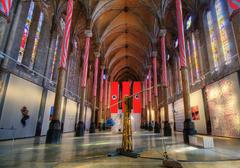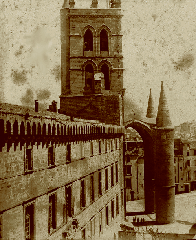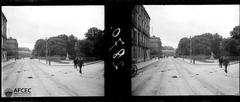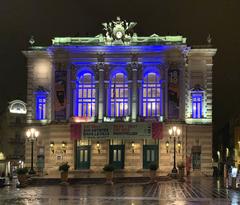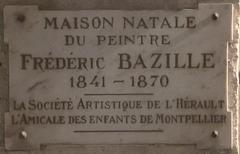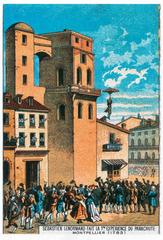
Basilica of Our Lady of the Tables: Visiting Hours, Tickets, and Historical Significance in Montpellier, France
Date: 04/07/2025
Introduction
In the vibrant heart of Montpellier, France, the Basilica of Our Lady of the Tables (Basilique Notre-Dame-des-Tables) stands as a testament to the city’s layered spiritual, commercial, and cultural history. Documented as early as 1090, this landmark owes its evocative name to the money changers’ tables that once surrounded the church, symbolizing the fusion of commerce and faith that marked medieval Montpellier. Over the centuries, the basilica has welcomed pilgrims on the route to Santiago de Compostela, served as a hub for the city’s bustling marketplace, and played a key role in Montpellier’s academic and cultural life (musee.info, Condé Nast Traveller).
The current Baroque structure, designed in the early 18th century by Jean Giral, rose from the ruins of its medieval predecessor, which was destroyed during the Wars of Religion. Its ornate façade and rich interior reflect the artistic sensibilities of its era, while the crypt preserves vestiges of the original Romanesque church. Today, the basilica continues to host religious services, concerts, and cultural events, making it a living part of Montpellier’s urban fabric (montpellier-tourisme.fr, France Voyage).
This comprehensive guide details the basilica’s history, architecture, and cultural significance, as well as essential information for visitors, including opening hours, tickets, accessibility, nearby attractions, and practical tips to enhance your experience.
Origins and Historical Development
The Basilica of Our Lady of the Tables traces its origins to at least the late 11th century, when it was first known as the chapelle Sainte-Marie. Its strategic location—now Place Jean Jaurès—placed it at the crossroads of medieval trade and pilgrimage, contributing to Montpellier’s rise as a commercial and spiritual hub (musee.info).
By the 12th century, the church had become a significant stop for pilgrims on the Camino de Santiago, renowned for its revered Black Madonna statue (Vierge noire). The influx of travelers fostered a thriving marketplace around the church, where merchants and money changers set up their tables, giving rise to the church’s unique name. The area quickly became synonymous with the spice trade and cosmopolitan exchanges, reflecting the diverse influences that shaped Montpellier.
Architectural Evolution
The original church featured Romanesque architecture with robust stonework and semicircular arches. Although the medieval structure suffered extensive damage during the 16th-century Wars of Religion, the crypt still preserves traces of the original building (montpellier-tourisme.fr). In the early 18th century, Jean Giral designed the current Baroque basilica, characterized by:
- A symmetrical façade with ornate stone carvings and a restrained bell tower
- Luminous nave with vaulted ceilings and gilded accents
- Richly decorated side chapels
- The grand organ, a highlight for music lovers and concertgoers
The crypt, now housing archaeological displays and funerary monuments, serves as the Musée du Vieux Montpellier, offering visitors a glimpse into the city’s religious past.
Religious and Cultural Significance
Notre-Dame-des-Tables has always been more than a place of worship. In the Middle Ages, its association with the pilgrimage to Santiago de Compostela made it a spiritual waypoint for thousands. The surrounding marketplace fostered a unique blend of sacred and secular activities, with merchants and pilgrims mingling in the bustling square (Condé Nast Traveller).
The church was also deeply tied to Montpellier’s medical school, one of the oldest in Europe. In the 14th century, academic ceremonies and dissections were held in the church, underscoring the close relationship between faith and science in medieval society (musee.info).
After considerable destruction during the Wars of Religion, the basilica was rebuilt and adapted over time, serving various functions, including as a Jesuit chapel and even as a lycée (secondary school). In 1939, Pope Pius XII elevated it to the status of minor basilica, cementing its importance to the Catholic community (France Voyage).
Artistic Heritage
The basilica boasts a remarkable collection of religious art, including:
- “L’Extase de saint François de Salles” (19th century)
- “La Naissance de la Vierge” (17th century)
- “L’Assomption” (early 19th century)
Its Baroque architecture and the 18th-century organ are highlights for visitors, while the Marian imagery and references to the lost Black Madonna (Notre-Dame-des-Tables) reflect the site’s deep spiritual roots.
Location and Accessibility
Address: Rue de l’Ancien Courrier, Montpellier, in the city’s historic center, near Place Jean Jaurès.
The basilica is easily accessible on foot from the Place de la Comédie and the Écusson district. The nearest tram stop is “Comédie,” a five-minute walk away. Visitors arriving by car can use nearby parking facilities such as Parking Comédie or Parking Triangle, though these may be limited during busy periods (Triphobo).
Accessibility: The main entrance is at street level and accessible to wheelchairs, though the crypt and some interior areas may have steps or uneven floors. Contact the basilica for specific accessibility needs.
Visiting Hours and Tickets
- Opening Hours: Daily, typically 9:00 AM – 6:00 PM. Hours may vary on public holidays and during special events; consult the official schedule before your visit.
- Tickets: Entry is free. Donations to support the basilica’s preservation are appreciated. Tickets may be required for special guided tours or concerts.
Guided Tours: While regular guided tours are not always available on-site, city walking tours often include the basilica, offering expert insights into its history and art. Brochures and plaques (in French and sometimes English) are available for self-guided exploration.
Visitor Experience and Practical Tips
Duration: Most visitors spend around 30–45 minutes exploring the main nave, side chapels, Baroque décor, and crypt.
Best Time to Visit: Afternoons between 3:00–4:00 PM offer optimal lighting and a quieter atmosphere. Check the Mass schedule to avoid coinciding with religious services if you prefer to tour the basilica undisturbed.
Dress Code: Modest attire is required—cover shoulders and knees, and remove hats inside.
Facilities: No restrooms are available inside, but public facilities are nearby in the city center. Numerous cafés, bakeries, and shops are found in the surrounding streets.
Photography: Permitted without flash, except during religious services. Respect worshippers and ongoing ceremonies.
Special Events and Activities
The basilica hosts regular Masses, liturgical celebrations, concerts (notably during the Festival Radio France Montpellier Occitanie), and community gatherings. Special events, such as the annual feast on January 20th, celebrate Our Lady of the Tables. For current schedules, consult local listings or the basilica’s website.
Nearby Attractions
- Place Jean Jaurès: Lively square with cafés and shops
- Musée Fabre: One of France’s leading art museums, housed in a former Jesuit college
- Saint-Pierre Cathedral: Gothic landmark nearby
- Promenade du Peyrou: Panoramic views and historic monuments
- Ecusson District: Medieval streets, artisan boutiques, and vibrant markets
Frequently Asked Questions (FAQ)
Q: What are the basilica’s opening hours?
A: Daily, generally 9:00 AM–6:00 PM (check holiday schedules).
Q: Is there an admission fee?
A: No, entry is free; donations are welcomed.
Q: Is the basilica wheelchair accessible?
A: The main entrance is accessible; some interior areas have limited access.
Q: Are guided tours available?
A: Occasionally; city walking tours often include the basilica.
Q: Can I take photographs inside?
A: Yes, but not during services and without flash.
Q: What other attractions are nearby?
A: Place Jean Jaurès, Musée Fabre, Saint-Pierre Cathedral, Promenade du Peyrou.
Summary and Traveler Tips
The Basilica of Our Lady of the Tables is a living monument to Montpellier’s multifaceted history. Its free admission, central location, and rich program of religious and cultural activities make it an essential stop for all visitors. To make the most of your visit:
- Arrive during quieter afternoon hours for a more peaceful experience.
- Respect the sacred atmosphere and dress code.
- Consider joining a guided city tour for deeper context.
- Explore the surrounding historic center to enrich your cultural outing.
- Use public transport or nearby parking to access the site easily.
For up-to-date information, schedules, and event listings, consult the official basilica page and local tourism resources. Enhance your visit with the Audiala app for audio guides and maps (Audiala).
Sources and Further Information
- Musée.info: L’Eglise Notre-Dame-des-Tables
- Montpellier Tourisme: Eglise Notre-Dame-des-Tables
- Condé Nast Traveller: Travel Guide Montpellier
- France Voyage: Basilique Notre-Dame des Tables, Montpellier
- Triphobo: Basilique Notre-Dame des Tables, Montpellier
- Horaire Messes: Basilique Notre-Dame des Tables, Montpellier Mass Schedule
- Montpellier Tourist Office: Notre-Dame des Tables Church, Montpellier
- Audiala: Audio Guides and Travel Apps


